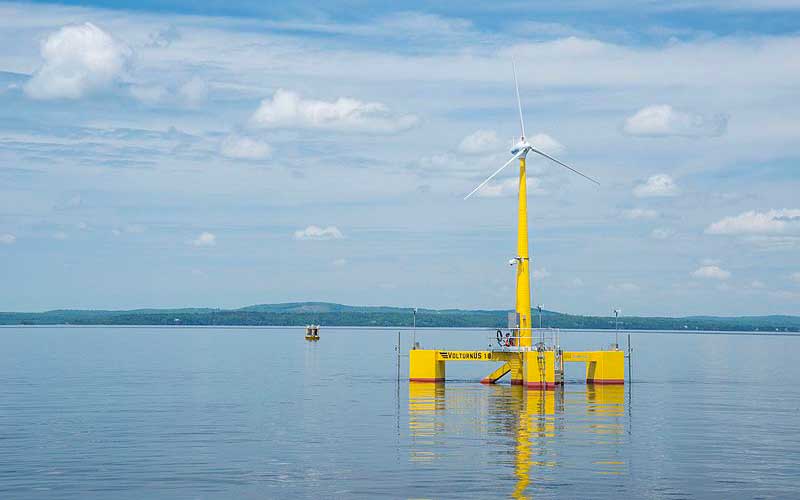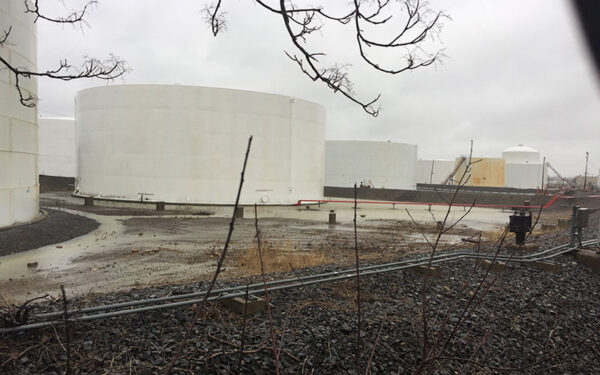
The University of Maine has designed a floating turbine (above) that can be used in the Gulf of Maine's deep waters. A pilot project with two of these turbines has just been given the green light by Maine regulators. Photo: JPlourde, UMaine, CC-by-SA 4.0
Home to some of the world’s strongest offshore winds, the Gulf of Maine can play an essential role in helping meet New England’s climate goals. But the energy of those winds has yet to be harnessed. Over the last decade, progress on this front stalled due in large part to the anti-wind policies of former Governor LePage. He abandoned the strategy established under the Baldacci administration and drove away Statoil, the world’s 11th largest energy company, from building a project off the Maine coast.
With the Mills administration, however, our clean energy economy may not only get back on track but make up for lost time. Earlier this year, Governor Mills signed a law committing the state to an 80% reduction in emissions by 2050. She also issued an executive order committing the state to a carbon-neutral economy by 2045. As part of that effort, Maine has also established a legally binding goal of installing 5,000 megawatts of offshore wind capacity by 2030, enough to power a million homes.
Now, three recent developments are bringing us closer to seeing clean energy generation in the waters off Maine and other New England states.
Floating Wind Project off Monhegan Island Gets Go-Ahead from Regulators
In early November, the Maine Public Utilities Commission approved an agreement under which Central Maine Power will purchase electricity from Aqua Ventus, the developer of a pilot offshore wind project. The project will generate 12 megawatts of power with two floating turbines near Monhegan Island and could be operational as soon as 2022.
This marks an important step in the development of offshore wind in the Gulf of Maine. While its winds blow strongly – making the clean energy potential enormous – the Gulf’s waters are too deep for conventional offshore wind turbines that rise from the seabed floor. Instead, the Aqua Ventus turbines will float on the water and be tethered to the sea bottom.
While already in use in Europe, floating turbine technology has yet to be developed in the United States. This project will play a key role in advancing our understanding and expertise with this technology. It will also bear economic benefits, as Public Utilities Commission Chair Phillip Bartlett recently noted: “If this takes off, there’s a real opportunity for economic development, both in the production and then the rollout of offshore wind turbines in the year ahead.”
$5 Million Federal Grant Will Further the Development of Floating Platforms
The University of Maine has been a critical partner in the Aqua Ventus project, having already developed platforms capable of holding the two 6-megawatt turbines planned for the Monhegan pilot project. A recent $5 million grant from the U.S. Department of Energy will allow the university’s Advanced Structures and Composites Center to further its work on a 12-megawatt, single-platform design. Such a design would double the power output of a single turbine while reducing the hardware in the water and any potential impacts on the environment and fisheries.
New Offshore Wind Task Force Will Advance Clean Energy Development in the Gulf of Maine
Finally, the federal Bureau of Ocean Energy Management (BOEM) recently announced that it had established a regional, inter-governmental task force to explore clean energy opportunities in the Gulf. The task force’s charter indicates that the group will collaborate to “exchange information and inform BOEM’s mission to facilitate the responsible development of renewable energy resources.” It is sure to advance needed cooperation and coordination among the Gulf of Maine states as they pursue offshore wind development.
The task force will include representation from Maine, New Hampshire, Massachusetts, and recognized Tribes in the area. Their first meeting, on December 12, 2019, is open to the public, who will have the opportunity to comment. BOEM has established similar task forces for lease areas off the shores of New York/New Jersey and Massachusetts/Rhode Island. CLF will be closely monitoring the work of the Gulf of Maine Task Force and participating in the group’s public meetings.
Much work remains before we see offshore wind farms in Gulf of Maine water. This work includes ensuring that the turbines and the transmission infrastructure needed to move the power to the shore are designed to protect our fisheries and endangered North Atlantic right whales.
But these recent developments offer encouragement that our state and federal governments are committed to offshore wind development in the Gulf of Maine, which is critical in our fight against climate change.



